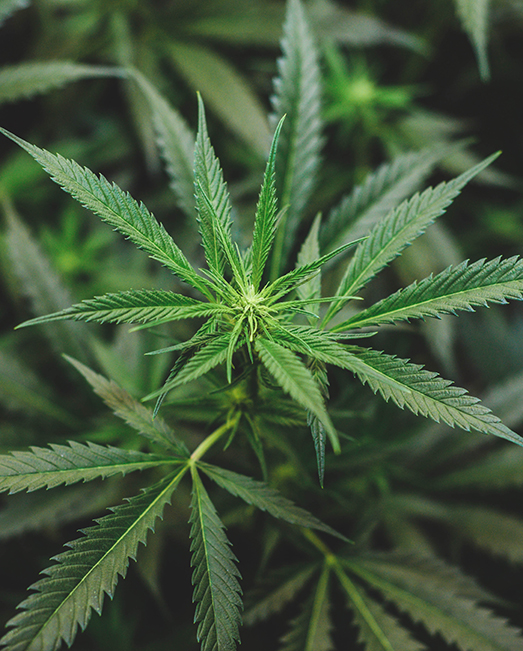Global
Copyright@ Australian Catholic University 1998-2025 | ABN 15 050 192 660 CRICOS registered provider: 00004G | PRV12008
Copyright@ Australian Catholic University 1998-2025 | ABN 15 050 192 660 CRICOS registered provider: 00004G | PRV12008

In recent years, the global movement to legalise cannabis has been gathering pace like a runaway steam train. Marijuana laws are in a period of liberalisation in many parts of the world – and in Australia, acceptance of the drug is so widespread that most people now support nationwide decriminalisation.
Meanwhile, interest around the plant’s therapeutic benefits is at an all-time high, with many touting its potential to alleviate pain and treat various medical conditions.
Alongside this buzz, experts fear that the scientific knowledge of the plant – its potential pros and its cons – is not keeping up with up policy shifts and an ever-expanding industry.
“It’s not so much a fear, it’s a reality,” says Dr Valentina Lorenzetti, an addiction neuroscience expert who has studied cannabis as a health risk and potential therapeutic agent.
“Cannabis is being decriminalised in many places, and that means accessibility has increased while risk perception has decreased – but there is still a lot we don’t know about the greatest harms and the effects on the most vulnerable users.”
Repeated studies (see here, here, here and here) have shown that the softening of regulation is often followed by a rise in heavy marijuana use. And although cannabis research has increased exponentially in recent years, mirroring the enthusiasm towards the plant itself, there is much about it that remains a mystery.
“We’ve definitely seen more interest in the potential harms, and there’s also been a spark in medical cannabis research, and in that sense, it’s an exciting area to work in,” says Dr Lorenzetti, an Associate Professor and Deputy Director of ACU’s Healthy Brain and Mind Research Centre.
“But in an ideal world, research should pave the way forward, and instead, we’re really playing catch up with all the changes that are happening. And if you compare the amount of research with the actual applications and the uses of cannabis, it’s pretty scary to see that gap.”
More than a decade ago, when Dr Lorenzetti’s work on addiction began to involve collaborations with overseas researchers, she started to notice that in cannabis research, there were no standardised ways of gathering data.
“I’ve been involved with lots of multi-site studies, where there might be a researcher from the Netherlands, a researcher from the United States and a researcher from Spain, and the methods they use to measure cannabis consumption are quite different,” she says.
“I found the same thing with systematic reviews – one study shows that there’s no harm, five show that there is harm, and two show that there’s a middle ground – but when you look at the samples, some studies measure the frequency of use in days, others measure occasions over the past month, and there’s often no detail on how much was consumed. Similarly, some studies measure consumption with grams, while others measure how many joints the person has smoked – and these are measures you cannot directly compare.”
The situation is even further complicated by the fact that cannabis is itself a complex substance.
“Users can consume it in so many ways – joints, bongs, vaping, drinks, gummy bears and other edibles – so it’s not as straightforward as alcohol,” says Dr Lorenzetti, who also points out that concentrations of THC, the main psychoactive ingredient in cannabis, have increased internationally and vary substantially across different marijuana products.
The complexity and the overall lack of data cohesiveness has widespread implications, limiting the potential of cannabis research at a time when the knowledge base needs to expand rapidly.
Says Dr Lorenzetti: “It hinders our overall understanding of the health effects of cannabis, and it means that as a global research community, we haven’t done a really good job of joining forces. With all the data we’ve collected over the years, we can’t integrate the knowledge straightaway because we’re comparing pears with apples.”
Realising the need to bridge the gulf between cannabis progress and scientific evidence, a group of leading researchers have been working to smooth the way for international collaboration.
The story begins with Dr Lorenzetti teaming up with Dr Tom Freeman, Director of the Addiction and Mental Health Group at the University of Bath, to develop a standard unit to measure cannabis intake.
In 2019, in an article published in Addiction, the researchers proposed that five milligrams of THC should be set as a standard dose – a cannabis equivalent to the standard drink that has long been associated with alcohol consumption.
“This was like a first step to establish a standard dose within cannabis research,” says Dr Lorenzetti, acknowledging that the field of cannabis research has been historically characterised by a lack of consensus on what a standard unit of cannabis is.
“We know that THC is responsible for the high that recreational users seek, as well as some of the medicinal benefits, and five milligrams was deemed as appropriate in that it induces intoxication in people without major adverse effects.”
In 2021, after an extensive information-gathering process, the measure was adopted by the National Institute on Drug Abuse, which stated that the development would “facilitate data interpretation and make it possible to design experiments on drug effects that have real-world relevance, as well as make it easier to translate that research into policy and clinical practice”.
The next step was to provide a comprehensive framework by which researchers could measure and record cannabis data.
This idea was first mooted at an international conference in Portugal, where Dr Lorenzetti again teamed up with Dr Freeman, along with a group of 25 world-class cannabis specialists, to form a consensus on the issue.
The result was the iCannToolkit, a simple tool that can be used by anyone from any discipline – from clinicians to researchers to members of the public – to reliably measure cannabis intake.
“I think there is a hunger out there to know more about cannabis because it’s so prevalent and people want to have a better understanding of their own use,” says Dr Lorenzetti, who believes that if the toolkit is adopted widely, it could be a “turning point” in cannabis research.
“It will mean that the data we gather will be better integrated and better understood, setting the groundwork for future collaboration, and from a knowledge perspective, I think that’s pretty big.”
So, with the path paved for greater cooperation between cannabis experts, what is the future for research in this space?
According to Dr Lorenzetti, there is much to be learned about this complex substance.
“There are so many new cannabis products coming on the market at the moment – vapes and gummy bears being two examples – but we don’t yet have comprehensive studies that compare the effects of these different products on a comparable sample,” she says.
“That means that we don’t have a standard that enables us to say, ‘Look, if you use this product, this is the length of intoxication that you can expect, and these are some adverse effects’. It’s going to take years to generate this data.”
Another area of interest is the effect that cannabis consumption has on young people – especially those with developing brains.
This is an area that Dr Lorenzetti and her team at ACU have been working on closely in recent times (examples here, here and here), noting that regular cannabis use amongst youths has been associated with depression, early school dropout, and diminished life satisfaction.
“We have to ask questions like, ‘What effect might legalisation have on young people’s behaviour and mental health?’, and ‘Who are the groups most at risk of harm?’,” she says.
“There are many people who use cannabis recreationally for fun with little or no harm, and there are others for whom cannabis is a major trigger – and at the moment, we don’t always know exactly who is who.”
As for the iCannToolkit, Dr Lorenzetti is hopeful that it will be taken up enthusiastically by the research community. If it is, it will undoubtedly help to broaden the knowledge base, and track changes and trends in the fast-moving cannabis movement.
“In the end, this is really about raising awareness and moving forward in a way that allows us to be more aware of the harms of cannabis, to help consumers to make more informed decisions, while also taking advantage of the emerging medicinal benefits in a way that is as safe as possible, and that minimises the risk of addiction.”
Dr Valentina Lorenzetti is a recognised expert in field of addiction neurosciences. Her research examines brain and mental health harms in chronic addictions and psychopathology, combining advanced multimodal neuroimaging tools, global multi-site cohorts and new interventions.

She is the Deputy Director of ACU’s Healthy Brain and Mind Research Centre, and Program Lead of the Neuroscience of Addiction and Mental Health Program.
Copyright@ Australian Catholic University 1998-2025 | ABN 15 050 192 660 CRICOS registered provider: 00004G | PRV12008